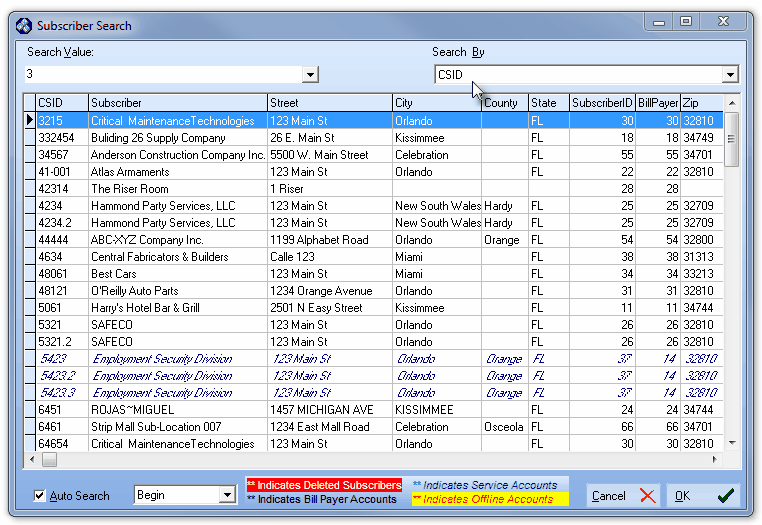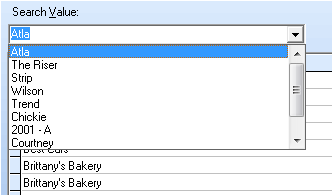| □ | Anytime a Subscribers Form is open, you may use the Subscriber Search function by pressing the F2 function key. |
| • | The Subscriber Search dialog (also accessible by Clicking the Search Icon at the top of the Subscribers Form) may also be presented to you in other situations when you need to locate a specific Subscriber record or an individual CSID. |

Subscriber Search dialog
| • | The records displayed are presented in one of four formats: |
| 2. | Black type in Italics on a white background - representing a Subscriber's Service Address record. |
| 3. | White type on a red background - representing a previously Deleted Subscriber record. |
| 4. | Red type on a yellow background - representing an Account that is Off Line. |
| • | Search By - The default Search By criteria is initially blank, then the default it becomes the one that was most recently selected. |
| • | Select the Search By field that will be used to locate the desired Subscriber. |
| • | Because there are more Search By options then initially listed, to see additional Search By options Drag the Right Slide Bar downward (see the illustration below) to view those remaining Search By options. |

Available Search By options
| • | The Subscriber Search listing on which the search will be performed will be ordered by (and the first column in the list will become) the selected Search By method. |
| ▪ | In the example below, Search By method chosen was CSID, the first column was changed to list CSID information, and the data listed will be in that order. |

Subscriber Search dialog with CSID selected as the Search By method and the Auto Search option turned on (Checked)
| • | Search Value - There are two Search Value entry methods available: |
| 1. | Enter some or most of the Subscriber's Name (or whatever the appropriate entry should be based on the selected Search By method). |
| 2. | Using the Drop-Down Selection List provided, you may Choose from one of the 10 most recently entered Search Values. |

| ▪ | If Auto Search is in effect (see "Auto Search" below), the record that most closely matches the entered Search Value (or selected from the Drop-Down Selection List) will be identified with a Right-Arrow4record pointer on the far left side of that record's row. |
| ▪ | If the Auto Search option is not Checked, Click the Search button (which will be displayed to the right of the Search Value field) to execute the search. |
| o | The appropriate record will be identified with a Right-Arrow4record pointer on the far left side of that record's row. |
| • | To Select the desired record, Click on that record line and then Click the OK ü button. |
| • | The Subscriber Search Form will Close and the selected Subscriber record will be displayed on the Subscribers Form. |
| • | Auto Search - Check this box to activate the Auto Search function. |
| • | Auto Search performs an incremental search as you type in your Search Value entry (see below). |
| • | By default, when Checked, the Auto Search function will be set for Begin, |
| • | However, using the Drop-Down Selection List, you may Choose any one of these three available methods to locate the needed record. |
| 1. | Begin - The Search Value you type will be compared to the beginning of the Search By criteria you selected. |
| 2. | Partial - The Search Value you type will be compared to the whole line of data to find any matching set of characters in the Search By criteria you selected. |
| ▪ | As an example, entering "MIT" would locate "SMITH". |
| 3. | End - The Search Value you type will be compared to the end of data to find a match based on the Search By criteria you selected. |
| ▪ | What you enter will be compared from the end back to the beginning of the field selected in Search By. |







